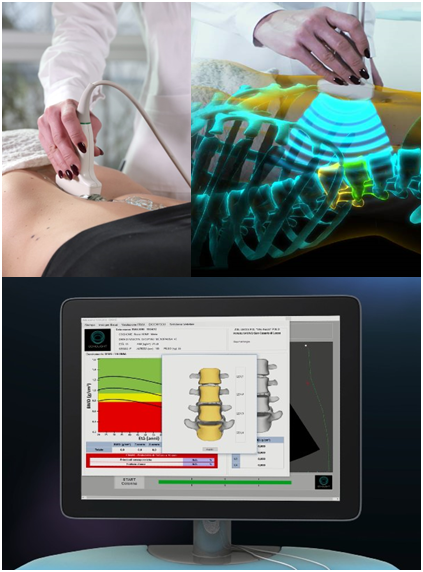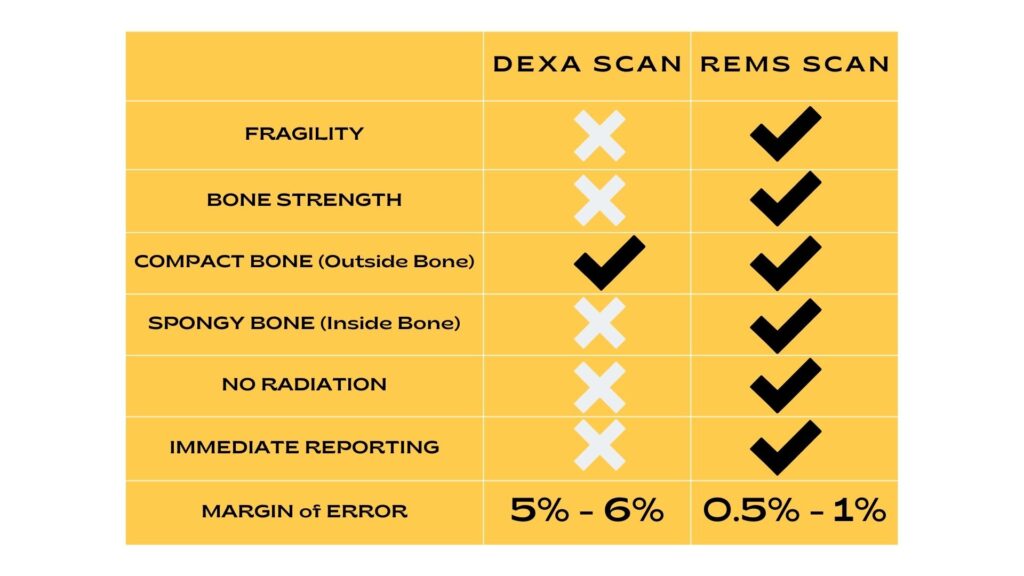What is echolight rems bone scan?
Echolight® REMS is an innovative bone health monitoring technology called REMS (Radiofrequency Echographic Multi Spectrometry) that is revolutionizing the way bone health specialists assess and monitor not only bone density, but also bone quality for more complete bone health insight.
How does Echolight® REMS work?
Echolight® REMS combines radiofrequency technology with echographic (ultrasound) capabilities, creating a unique synergy that enables it to provide a multi-dimensional analysis of your bone properties capturing not only bone density measurements but also a wide range of additional information regarding bone quality related to bone structure, composition, and health.
Echolight®’s REMS technology comprehensively examines the condition and health of a person’s bones with greater precision and accuracy without the ionizing radiation (X-rays) as compared with Dual-Energy X-Ray Absorptiometry (DEXA) technology.
Bone Quality is Important!
70% of hip fractures occur in individuals without osteoporosis.
Bone quality is a key determinant of fracture risk. Traditional measures, like bone density, tell us how much bone mineral content is present, but they don’t account for other aspects of bone health. High bone density doesn’t always mean strong bones, as quality also involves bone structure, texture, and strength.

Benefits and Advantages of REMS Technology
Non-Invasive & Radiation Free
A safer alternative for regular bone health monitoring especially for those undergoing radiation treatments.
More Precise, Accurate & Comprehensive
Unlike DXA scans that primarily measure bone mineral density (BMD), Echolight® goes beyond by providing a more precise and holistic assessment of bone health. It not only reports BMD but considers factors such as bone microarchitecture and composition offering a more complete understanding of an individual’s bone strength.
Microarchitecture Assessment
Analyzes trabecular thickness and connectivity, cortical thickness and porosity of bone.
5 year Risk of Fracture Assessment
Based on BMD and Fragility Score
Improved Prediction for Special Populations
Greater accuracy for patients with type II diabetes, osteoarthritis, scoliosis, rheumatoid arthritis or other risk factors.
Real-Time Imaging
Echolight®’s ability to provide real-time imaging within several minutes allows for instant visualization and analysis of bone properties right in our office.
Instant Reporting
T-score, Z-score, BMD and Fragility Score
Early Detection & Monitoring
Improved ability to detect low bone density and osteoporosis, at earlier stages (pregnancy and pre-menopause), even before traditional methods. This can lead to proactive interventions to prevent fractures and other bone-related complications.
Pre-Operative Bone Assessment
Prior to joint replacement or spine fusion surgery to assist in improved surgical interventions.
Portability
Echolight® is a portable technology, allowing it to be used in various care settings and making it accessible to a wider range of patients.
What does Echolight® REMS track?
With a quick and simple ultrasound, the Echolight® REMS technology allows an examiner to identify and scan a patient’s lumbar vertebrae (spine) and femur (total hip and neck) for density AND quality of bone microarchitecture.
The technology measures the most common bone health factor — bone mineral density (BMD) — and generates a T-score and a Z-score that are commonly used to diagnose osteoporosis. Unlike previous technology, Echolight® also calculates a measure of bone quality with a Fragility Score.
But what exactly do these data points tell you about your bone health?
BMD
This is an actual measurement of the density of the bone (measured in gr/cm2). The BMD is used to determine the T-Score and the Z-Score. A correct osteoporosis diagnosis is entirely dependent on accurate BMD data.
T-score
This is a numeric value derived through statistical calculations that directly compares an individual’s BMD to the mean BMD value of a very large database of healthy 30 year-old. A T-score value with a standard deviation of -2.5 from the mean value establishes a diagnosis of osteoporosis.
Fragility score
This is a numeric value calculated from scan data of microarchitecture, which is then compared to a diverse database of over 15,000 individuals with and without fractures. This score reflects bone quality and then combine with BMD estimates the likelihood of sustaining a fragility fracture within five years. Unique to Echolight® technology, this score provides a more personalized assessment of fracture risk than DEXA scans, helping to tailor preventive measures and appropriate treatments based on individual bone characteristics.
Z-score
This is a numeric value derived in a similar manner as the T-Score, but instead, it compares your BMD to the BMD of people your own age and gender.
Why Echolight® REMS versus DXA Scan

More Accurate & More Comprehensive
Echolight®’s technology is more precise and more comprehensive than the common DEXA Scan.
Comprehensive Assessment
Unlike DEXA scans that primarily measure bone mineral density, Echolight® goes beyond by providing a more holistic assessment of bone health. It considers factors such as bone microarchitecture, composition, and strength, offering a more complete understanding of an individual’s bone quality.
Non-Invasive & Radiation Free
Echolight® operates without the use of ionizing radiation (X-Rays), making it a safer alternative for regular bone health monitoring.
Real-Time Imaging
Echolight®’s ability to provide real-time imaging within several minutes allows for instant visualization and analysis of bone properties right in our office.
Instant T Score & Z Score
Echolight® provides patients with an instant T score and Z score.
Provides Fragility Score
Echolight®’s comprehensive analysis provides additional information that creates a personalized fragility score – which indicates an individual’s susceptibility to fractures and bone-related complications. This score takes into account an individual’s unique bone characteristics, providing a more accurate assessment of their risk profile. This is unique to Echolight® and not possible with the DEXA Scan. This fragility score helps tailor preventive measures and treatments based on the specific needs of the patient.
Early Detection & Monitoring
By offering a more detailed assessment of your bone health, Echolight® can potentially detect low bone density and osteoporosis, at earlier stages, even before traditional methods might show significant changes. This can lead to proactive interventions to prevent fractures and other bone-related complications. Establishing a bone density baseline is crucial for healthy aging, as bone density deterioration can begin as early as your 30s. By having a baseline measurement, individuals can track changes over time and take proactive steps to maintain bone health. EchoLight® REMS offers this opportunity, providing an affordable and effective way to monitor bone density without waiting until menopause or beyond. Early detection and intervention can help prevent osteoporosis and other bone-related issues, ensuring stronger bones and a healthier future.
Understanding the REMS Report
CLINICAL RESEARCH STUDIES
Radiofrequency Echographic Multi Spectrometry (R.E.M.S.): New Frontiers for Ultrasound Use in the Assessment of Bone Status—A Current Picture
A review evaluating the data on the REMS technique present in current literature.
Short-Term Precision and Repeatability of Radiofrequency Echographic Multi Spectrometry (REMS) on Lumbar Spine and Proximal Femur: An In Vivo Study
Determined the short-term intra-operator precision and inter-operator repeatability of REMS
Radiofrequency echographic multi spectrometry (REMS) in the diagnosis and management of osteoporosis: state of the art
Overview of REMS technology and current evidence base that supports the technology as a useful tool in the management of osteoporosis as an alternative to DXA.
Radiofrequency Echographic Multi Spectrometry (REMS) for the diagnosis of osteoporosis in a European multicenter clinical context.
Assesses the diagnostic accuracy of REMS with respect to DXA in a wider European clinical context.. Confirms diagnostic effectiveness of REMS technology at reference anatomical sites for the assessment of osteoporosis with femoral neck sensitivity of 90.4% and specificity of 95.5%. For lumbar spine scans, a sensitivity of 90.9% and a specificity of 95.1% were obtained.
REMS SCAN RESOURCES
Preparing for your Bone Scan
Below are instructions for preparation and additional information for your scan. Please read carefully and email us with any questions. We look forward to meeting you.
Please arrive 10 minutes early for your appointment time. The schedule is tight and accommodation for late arrivals is not guaranteed.
Empty your bladder or bowels before being called to the exam room. Arriving 10 minutes early will give you plenty of time to address bathroom calls.
Bring a towel if you are not comfortable on the exam table without one. Your personal towel will be placed on the exam table. You will be lying on your personal towel. Why? We are doing our best to minimize medical waste. Use of paper sheets over the table creates unnecessary waste during the REMS exam.
Wear comfortable, loose-fitting clothing. Your abdomen will be exposed first to perform the exam for the lumbar spine. To perform the exam for the hip, the inguinal crease (groin) will need to be exposed. You will be asked to bring your pants to mid-thigh to access the inguinal crease. Please wear underwear.
Avoid eating a meal or drinking 2-3 hours prior to your exam. Gas in the intestines will interfere with the lumbar spine exam.
Direct payment for service is accepted at the time of the exam.
Your test will be sent via email of your choice. It will not be a secure email. If you would like to have it at the time of your exam, please bring a USB drive with Windows PC compatibility.

